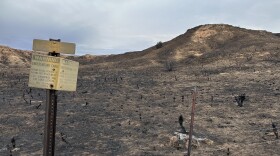After more than a week of destruction, including thousands of dead livestock and hundreds of lost structures, two of the largest fires that have been raging in the Texas Panhandle are now about 90% contained.
The Smokehouse Creek Fire, which scorched about 1,058,570 acres from Hutchinson County to Hemphill County, was 87% contained as of Friday morning according to the Texas A&M Forest Service. The Windy Deuce Fire in nearby Moore County was about 92% contained and had burned about 144,200 acres.
The latest figures should provide residents in the area with some small measure of relief after. Just one week ago, the same fires were only 15% and 60% contained, respectively.
The Smokehouse Creek Fire is the largest in Texas history and one of the largest the country has ever experienced.
Firefighting crews are also optimistic about weather conditions heading into the upcoming weekend. The Forest Service said Friday morning that the forecast has improved, and the environment “is not forecast to support an increased threat for large wildfires that are highly resistant to control.” That forecast is through Sunday, the agency added.
The fires have already killed thousands of livestock. Early estimates on the number of dead cattle alone are hovering around 7,000, CBS News reported. A more accurate assessment will be completed once the fires are extinguished, Texas Agriculture Commissioner Sid Miller told the Texas Newsroom last week.
It was also revealed earlier this week that power lines likely caused the two largest blazes.
On Thursday morning, Xcel Energy issued a statement acknowledging that “its facilities appear to have been involved in an ignition of the Smokehouse Creek fire,” the Texas Tribune reported.
Juan Rodriguez, a public information officer for the Texas A&M Forest Service, told Texas Standard that wind gusts exceeded 60 mph the day the fire began, likely causing some power lines to fall and spark the Panhandle blazes.
“When the winds are doing that, driving down the roadways, you can just see power lines just bouncing up and down,” he said. “It’s bound to cause one of these power lines to fail...One of them — or some of them — may have fallen.”
Rodriguez also explained that containment means the likelihood that a fire won’t spread beyond what’s already burning.
"They’re looking at what resources they have and all these things in order to base their confidence that this fire will no longer get out, make any more runs, and it won’t make any more threats to life and property safety,” he said.
Affected Panhandle residents continue to assess the damage and plan how to rebuild their homes, ranches and even their businesses. But one thing what hasn’t disappeared is their resolve.
Kristen Moudy, the economic development director for the city of Wheeler, told NPR that even Texans who lost everything are still finding ways to offer support to their neighbors.
When asked by what people would see if they arrived in the Panhandle this week, she said: “You would see people that have lost everything. They’ve lost ranches, they may have lost their homes, they may have lost cattle. And yet through that, they're standing in the ashes, pulling themselves together and saying ‘Come on guys, let’s do this! We’ve got it.’”
Copyright 2024 KERA. To see more, visit KERA. 9(MDA4OTAxNzAzMDEzMjc0MTc2MzA5ZDZlMw004))







